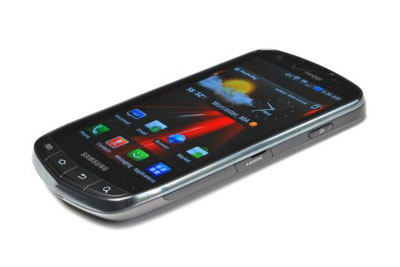Samsung Droid Charge 4G Verizon Smartphone Review
Design
The Droid Charge uses a typical candy bar form factor that seems to be quite popular among Android phones these days. One of the things that really sets the Droid Charge apart, however, is its large, 4.3-inch Super AMOLED Plus screen. The Super AMOLED Plus technology increases the number of sub-pixels from eight to twelve for an increase of 50% and use a regular RBG matrix. As a result, the screen is designed to offer more clarity and be more visible under bright light such as direct sunlight.
Click to enlarge
When we first picked up the Droid Charge, we immediately noticed how thin and lightweight it was. In fact, the Droid Charge is more than an ounce lighter than Verizon Wireless' other 4G LTE phone, the HTC Thunderbolt. Still, the Droid Charge isn't the lightest phone we've tested. Here's how the weight of the Droid Charge compares to a few other phones.
|
Samsung Galaxy S 4G |
4.2 ounces |
|
Samsung Captivate |
4.5 ounces |
|
Nexus S |
4.55 ounces |
|
HTC Droid Incredible |
4.6 ounces |
|
Apple iPhone 4 |
4.8 ounces |
|
Samsung Droid Charge |
5.04 ounces |
|
Motorola Droid X |
5.47 ounces |
|
Samsung Epic 4G |
5.47 ounces |
|
HTC EVO 4G |
6 ounces |
|
HTC Thunderbolt |
6.23 ounces |
Although we're seeing more high-end phones ship with dual-core 1GHz processors like NVIDIA's Tegra 2, many phones are still utilizing single-core 1GHz processors as well. The Droid Charge falls in the latter camp, coming with a single-core 1GHz Hummingbird processor.
With the exception of the Nexus S, most of today's Android-powered phones are also shipping with Android 2.2 (Froyo). The Droid Charge also ships with Android 2.2. Considering Google's new upgrade guidelines, we would expect that the Droid Charge and other popular phones should receive an update at some point in the future, though no update announcement has been made by Samsung.
The vast majority of the front of the Droid Charge is consumed by the 4.3-inch Super AMOLED Plus screen. Although the Droid Charge's screen did collect some fingerprints, we felt this screen did a better job at avoiding fingerprints than other phones we've seen in the past. Fingerprints or not, the screen always remained responsive.
Click to enlarge
Underneath the screen, you'll find four hardware buttons (Menu, Home, Back, and Search). You read that right—these are hardware buttons, not touch-sensitive icons. When you press any of these buttons, you'll hear a quiet click. The 1.3 megapixel front-facing web cam is above the display on the left side.
On the left edge of the Droid Charge, there is a volume rocker and microUSB port. You'll find the phone's power button and miniHDMI port on the right edge. At the top of the Droid Charge, there is a standard headphone jack.
Click to enlarge
Taking a look at the back of the Droid Charge, you'll see the rear-facing 8 megapixel camera and LED flash. At the base of the phone near the speaker, there is a slight bulge.
Underneath the battery cover, you'll find the microSD card slot, 4G LTE SIM card slot, and of course, the phone's battery. Both the SIM slot as well as the microSD slot is accessible without removing the battery.









